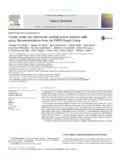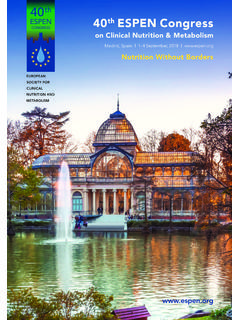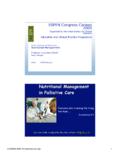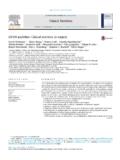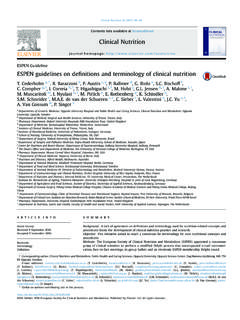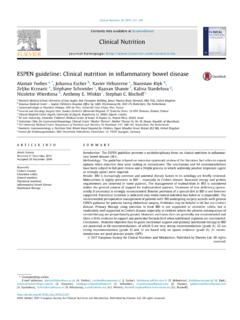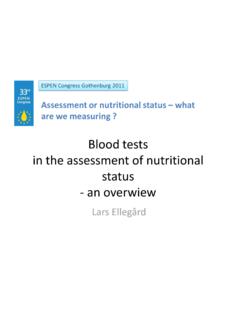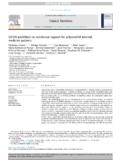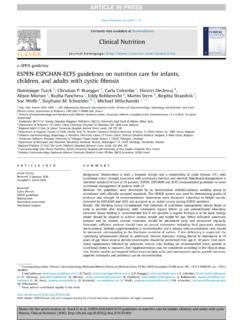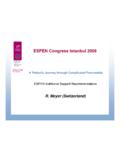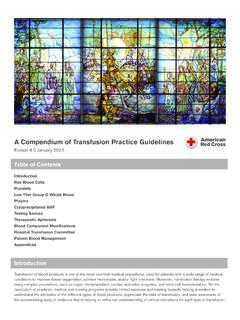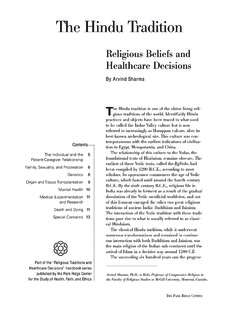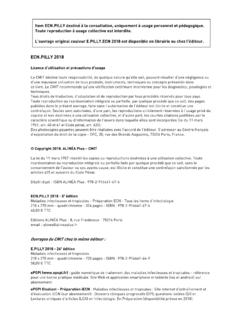Transcription of ESPEN guideline on clinical nutrition in hospitalized ...
1 ESPEN GuidelineESPEN guideline on clinical nutrition in hospitalized patients withacute or chronic kidney diseaseEnrico Fiaccadoria,*,1, Alice Sabatinoa,1, Rocco Barazzonib, Juan Jesus Carreroc,Adamasco Cupistid, Elisabeth De Waelee, Joop Jonckheerf, Pierre Singerg,Cristina CuerdahaNephrology Unit, Parma University Hospital,&Department of Medicine and Surgery, University of Parma, Parma, ItalybInternal Medicine, Department of Medical, Surgical and Health Sciences, University of Trieste, Trieste, ItalycDepartment of Medical Epidemiology and Biostatistics, Karolinska Institutet, Stockholm, SwedendNephrology Unit, Department of clinical and Experimental Medicine, University of Pisa, Pisa, ItalyeIntensive Care, University Hospital Brussels (UZB), Department of nutrition , UZ Brussel, Faculty of Medicine and Pharmacy, Vrije Unversiteit Brussel (VUB),Bruxelles, BelgiumfIntensive Care, UZ Brussel, Bruxelles, BelgiumgGeneral Intensive Care Department and Institute for nutrition Research, Rabin Medical Center, Beilinson Hospital, Sackler School of Medicine, TelAvivUniversity, Tel Aviv, IsraelhNutrition Unit, Hospital General Universitario Gregorio Mara~non, Instituto de Investigaci on Sanitaria Gregorio Mara~n on, Madrid, SpainKeywords.
2 Acute kidney diseaseAcute kidney injuryClinical nutritionEnteral nutritionKidney replacement therapyHospitalized patientsIntensive care unitMalnutritionMuscle wastingParenteral nutritionsummaryAcute kidney disease (AKD) - which includes acute kidney injury (AKI)eand chronic kidney disease(CKD) are highly prevalent among hospitalized patients, including those in nephrology and medicinewards, surgical wards, and intensive care units (ICU), and they have important metabolic and , in case kidney replacement therapy (KRT) is started, whatever is the modality used, thepossible impact on nutritional profiles, substrate balance, and nutritional treatment processes cannot present guideline is aimed at providing evidence-based recommendations for clinical nutrition inhospitalized patients with AKD and CKD.
3 Due to the significant heterogeneity of this patient populationas well as the paucity of high-quality evidence data, the present guideline is to be intended as a basicframework of both evidence and - in most cases - expert opinions, aggregated in a structured consensusprocess, in order to update the two previous ESPEN Guidelines on Enteral (2006) and Parenteral (2009) nutrition in Adult Renal Failure. Nutritional care for patients with stable CKD ( , controlled proteincontent diets/low protein diets with or without amino acid/ketoanalogue integration in outpatients up toCKD stages four andfive), nutrition in kidney transplantation, and pediatric kidney disease will not beaddressed in the present guideline .
4 2021 European Society for clinical nutrition and Metabolism. Published by Elsevier Ltd. All IntroductionThe present guideline represents an updating and expansion ofthe existing ESPEN Guidelines on Enteral nutrition in Adult RenalFailure 2006 [1] and Parenteral nutrition in Adult Renal Failure2009 [2] and has been jointly prepared by a multidisciplinary groupof experts from different specialties (Nephrology, Intensive CareMedicine, Internal Medicine) based on the new methodologydefined by the Standard Operating Procedures for the ESPENG uidelines and Consensus Papers [3].The aim of the project has been the development of guidelinesfor hospitalized patients with acute kidney injury/acute kidneydisease (AKI/AKD) and/or chronic kidney disease (CKD) with orwithout kidney failure (KF).
5 This guideline is not intended to be*Corresponding author. Nephrology Unit, Medicine and Surgery Dept. ParmaUniversity, Via Gramsci 14, 4310, Parma, Fiaccadori).1 Both Authors equally contributed to the lists available atScienceDirectClinical Nutritionjournal homepage: 2021 European Society for clinical nutrition and Metabolism. Published by Elsevier Ltd. All rights nutrition 40 (2021) 1644e1668applied in the outpatient setting of stable patients with CKD stages1e5 or on chronic dialysis. Abnormal kidney function, usuallyindicated in the literature with the broad terms AKI/AKD or CKD, ishighly prevalent among hospitalized patients in different clinicalsettings, including nephrology and internal medicine wards, sur-gery wards, and intensive care units (ICU).
6 As far as nutrition isconcerned, the approach to these patients when hospitalized ishighly complex since they represent a very heterogeneous group ofsubjects, with variable and widely differing metabolic character-istics and nutritional all of these clinical settings AKI/AKD and CKD (especially in itsmost advanced stages, from 3 to 5), as well as their specific treat-ments, may have important adverse effects on both substratemetabolism and nutritional status. Moreover, in case kidneyreplacement therapy (KRT) is started, and whatever is the modalityused (conventional intermittent hemodialysis; prolonged inter-mittent kidney replacement therapies PIKRT), or continuous kidneyreplacement therapies (CKRT), its impact on nutritional profile,substrate balance, and nutritional treatment processes cannot present guideline is aimed at providing evidence-basedrecommendations for clinical nutrition in hospitalized patientswith AKI/AKD or CKD.
7 Due to the paucity of high-quality evidencedata, the present guideline is to be intended as a basic framework ofboth evidence and - in most cases - expert opinions, aggregated in astructured consensus process. Nutritional care for outpatients withmetabolically stable CKD ( , patients on controlled protein con-tent diets with or without amino acid/ketoanalogue integration), aswell as nutrition in kidney transplant or pediatric KD will not beaddressed here. As will be discussed more in-depth in the followingsection, the 2012 nomenclature of the Kidney Disease ImprovingGlobal Outcomes (KDIGO) for AKI and AKD [4], and the 2012 KDIGO nomenclature for CKD [5], as recently updated in a 2019 KDIGO consensus conference [6] will be applied in the General aspects and guideline development processThe present guideline started as a basic framework of evidenceand expert opinions subsequently structured into a consensusprocess following the standard operating procedure for the devel-opment of ESPEN Guidelines [3].
8 On this basis, the concept of Medical nutrition aimed at prevention and treatment of malnu-trition in the context of diseases was focused on, with a compre-hensive approach not separating enteral nutrition (EN) andparenteral nutrition (PN) as in the past ESPEN guidelines for adultrenal failure, and including screening, assessment, nutritionalcounseling, oral nutritional supplements (ONS), as well as EN andPN [7]. Thus, the present guideline is an update and revision of thetwo existing ESPEN guidelines, respectively on Enteral nutrition inAdult Renal Failure 2006 [1] and on Parenteral nutrition in AdultRenal Failure 2009 [2]. The two previous guidelines were joinedand integrated by a multidisciplinary working group of sevenspecialists (Nephrology, Intensive Care, Internal Medicine) fromthree European countries (Italy, Sweden, Belgium), based on thenew methodology defined by the standard operating proceduresfor the ESPEN Guidelines and consensus papers [3].
9 The workinggroup members declared their conflicts of interest according to therules of the International Committee of Medical Journal Editors. Noindividual employed by the industry was allowed to participate inthe guideline development process. No industry sponsoring wasobtained, and the costs for the development process of the guide-line were entirely covered by ESPEN . The new ESPEN guidelinestandard operating procedures [3] is based on the methodologyfollowed by the Association of Scientific Medical Societies of Ger-many, the Scottish Intercollegiate Guidelines Network (SIGN), andthe Centre for Evidence-based Medicine at the University of , a sequential approach is requested, that includes thestructuring of clinical questions according to the PICO system (Pa-tient, Intervention, Control, Outcome)
10 When possible, systematicliterature search, with the evaluation of recent other relevantguidelines/consensus, and the identification of specific clinical questions were also structured, concerning basicand general concepts related to acute and chronic kidney diseases,definitions regarding renal function impairment syndromes, clas-sifications of AKI/AKD, and CKD, KRT modalities, and question led to one or more recommendation/statement andrelated commentaries. Different topics concerning nutrition inhospitalized patients with AKI/AKD or CKD were covered, such asthe metabolic background of reduced renal function, the metaboliceffects of AKI/AKD, AKI on CKD with or without KRT, CKD, and CKDon KRT, screening of patients at risk, nutritional status assessment,indications and timing of nutritional support, route of feeding,macro- and micronutrient requirements, disease-specific nutrientuse, integration of nutritional therapy with KRT.
